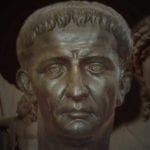 Weird Stuff
Weird Stuff  Weird Stuff
Weird Stuff  Animals
Animals 10 Inspiring Tales of Horses Being Human
 Mysteries
Mysteries Top 10 Haunting Facts About the Ghost Ship MV Alta
 History
History 10 Surprising Stories About the Texas Rangers
 Humans
Humans 10 Philosophers Who Were Driven Mad by Their Own Theories
 Miscellaneous
Miscellaneous 10 Video-Game-Worthy Weapons and Armors from History
 Weird Stuff
Weird Stuff 10 Psychics Who Accurately Predicted Wartime Events
 The Arts
The Arts 10 Pieces of Art Inspired by a Broken Heart
 Health
Health 10 Science Fiction-Sounding New Medical Treatments
 History
History 10 Surprising Facts About the Father of Submarine Warfare
 Weird Stuff
Weird Stuff 10 Times Real Laws Were Based on Bizarre Hypotheticals
 Animals
Animals 10 Inspiring Tales of Horses Being Human
 Mysteries
Mysteries Top 10 Haunting Facts About the Ghost Ship MV Alta
Who's Behind Listverse?

Jamie Frater
Head Editor
Jamie founded Listverse due to an insatiable desire to share fascinating, obscure, and bizarre facts. He has been a guest speaker on numerous national radio and television stations and is a five time published author.
More About Us History
History 10 Surprising Stories About the Texas Rangers
 Humans
Humans 10 Philosophers Who Were Driven Mad by Their Own Theories
 Miscellaneous
Miscellaneous 10 Video-Game-Worthy Weapons and Armors from History
 Weird Stuff
Weird Stuff 10 Psychics Who Accurately Predicted Wartime Events
 The Arts
The Arts 10 Pieces of Art Inspired by a Broken Heart
 Health
Health 10 Science Fiction-Sounding New Medical Treatments
 History
History 10 Surprising Facts About the Father of Submarine Warfare
Top 10 Law Enforcement Agencies Of The Ancient World
Although incredibly different in many ways, the ancient world wrestled with the same problems that governments do today. As long as there have been people, there had been cops and robbers, and from the Inca to India, each society was policed as they saw fit. Here are ten law enforcement agencies that patrolled the ancient world.
10 Amazing Ancient Buildings Still In Use Today
10 The Paqudu of Babylon
The Mesopotamian kingdom of Babylon is best known for its Code of Hammurabi, the first list of crimes and punishments ever created. The set of laws was carved onto stone pillars sometime in the tenth century BC.
As Babylon grew rich in the 6th century BC, so did their ability to maintain law and order. Their police officers, called padudu, were locals appointed with the task of protecting the town. The job was far from glamorous. Temple records describe the paqudu responding to a noisy tavern party, investigating a missed barely payment, and arresting looters for the destruction of temple property. When a sacred cow disappeared from its stable, the paqudu searched the neighborhood for suspiciously large amounts of fresh beef. Upon finding the tasty contraband, they turned it over to the court as evidence.[1]
9 The Medjay and Temple Priests of Egypt
The ancient Egyptians were all about living in harmony, which they called Ma’at. But law enforcement was sometimes needed to maintain that harmony.
Egypt’s earliest police officers guarded public spaces with wooden sticks and trained attack dogs (and occasionally monkeys!) As Egypt expanded during the Middle Kingdom, Medjay warriors from the neighboring kingdom of Nubia offered their services as keepers of the peace. They became the bulk of the Egyptian police force, to the point where ancient Egyptian Chiefs of Police were referred to as “Chief of the Medjay,” even when native Egyptians had long since taken over the job.
During the New Kingdom, there was a special unit of police that served as temple priests. Their job was to preserve the sanctity of the temples by ensuring proper behavior during religious festivities. But if a crime involved a temple, they got to conduct their own criminal investigations.[2]
8 The Krypteia of Sparta
Derived from the Greek word for “hidden,” the krypteia was Sparta’s secret police force. Instead of the typical Greek heavy armor and weapons, they carried easily concealed knives for clandestine kills. Hardened by training in the mountainous countryside with few rations and equipment, they were experienced warriors and excellent assassins.
The krypteia’s main enemy was the helots; Sparta’s agricultural serfs who had no choice but to work the land. The helots periodically revolted against their enslavement, so the krypteia were tasked with terrorizing them into submission. They would hide in the countryside, sleeping by day and killing stray helots by night. They were particularly interested in dispatching large men who might become threatening warriors.
At one point, the Spartans offered freedom to veteran helots. As the Greek chronicler Thucydides wrote, “As many as two thousand were selected accordingly…rejoicing in their new freedom. The Spartans, however, soon afterwards did away with them, and no one ever knew how each of them perished.” There is little doubt who carried out these assassinations.[3]
7 The Scythian Archers of Athens
Athens was the world’s first democracy, so Athenian citizens couldn’t go around arresting each other without cries of hypocrisy. This led to the government purchasing 300 Scythian archers as public slaves. It was simply the democratic thing to do.
The only contemporary accounts of the Scythian police force come from the comedic plays by Aristophanes, where they are portrayed as bumbling idiots. In Lysistrata, the Scythians attempt to arrest the eponymous heroine only to be soundly defeated by a mob of angry women. In another, a man under arrest makes several attempts to distract his Scythian guard and escape, finally succeeding with the help of a sexy dancer.[4]
It is unlikely that the Scythian archers, despite their name, arrested citizens at arrow point. Rather, skill with a bow was a well-known Scythian stereotype and the name stuck.[5] Some Scythians formed close relationships with Athenians and received Greek burial steles. The discovery of 80 arrowheads at a grave in Cerameicus suggests it may be for a police chief, perhaps killed in action.
6 The Mauryan Gops
India’s first empire was the Mauryan Empire, which ruled the subcontinent from 321 to 185 BC. Their military and civil service were the envy of the ancient world.[6] Each town had a nagarik, a police chief, with officers (Gops) at his command. Though appointed by the emperor, they were watched closely by local leaders known as Gramini. Police stations served as a local jail, a lost-and-found, and a census bureau.
In addition to keeping the citizens safe, the Gops were omnipresent spies for the state. Anyone entering the city had to be meticulously recorded and their whereabouts watched. Regular patrols of neighborhoods ensured everyone’s activities were known by the police, and any suspicious people were arrested, even if they were innocent, so they didn’t have an opportunity to commit a crime.[7]
10 Stories From The Ancient World That Need A Movie
5 Judaean Shoterim
The Jewish occupants of ancient Judaea had a rigorous court system that held public safety in high regard. Every town had a judge, and the court employed two shoterim to carry out the court’s orders. Their duties included checking weights and measures for tampering, setting market prices, inspecting property boundaries, and dispensing charity. Their salaries were paid through local taxes.
Ancient Judea had a large number of public safety regulations that were strictly enforced. Dogs needed to be chained up, pits needed to be covered, and the sale of weapons was regulated. If a property owner had an unsafe structure or tree, they were issued a thirty-day warning to remove it. If anyone witnessed their neighbor in mortal danger, they had a legal obligation to help.[8]
4 The Cadi of the Songhai Empire
The Songhai Empire was the largest ever in West Africa, so it needed a top-notch police force. Among its many, many government officials were the Cadi. These civil servants were appointed by the king to deal with local disputes. They decided which grievances got a tribunal, then presided over the tribunal and determined the punishment. If the crime was of interest to the public, a town crier would shout the latest news in the town center.
As servants of the king, the Cadi were always on the lookout for treason. Political offenses received the harshest punishments, with one low-level minister ending up sewn inside of a bull’s hide and burned alive.[9]
3 Incan tokrikoq
The Incans of the modern-day South American coast ran a well-organized empire and were similarly meticulous with their legal system. Tradition dictated that an Incan subject accused of a crime could only be judged by someone of a higher rank, so the local tokrikoq (which literally translates to “he who sees all”) was the highest-ranking government official in the area. In addition to overseeing justice, the tokrikoq oversaw the census, land distribution, and the maintenance of public roads and bridges.[10]
If the tokrikoq delivered a guilty verdict, imprisonment was not an option for the criminal. Incan punishment was meant to deter potential offenders, so all proceedings had to be as public as possible. Murder, rebellion, adultery, drunkenness, and laziness could all be punished by death via stoning, hanging, or getting thrown off a cliff. Minor crimes were given a public scolding.[11]
2 Ancient Roman Vigiles
The Roman Empire tried many different kinds of law and order throughout their long rule of the Mediterranean. The Praetorian Guard and the Cohorts Urbanes guarded the emperor and the cities, but petty crimes and firefighting were left to the Vigiles.
In 21 BC, Roman senator Marcus Egnatious Rufus received overwhelming praise for ordering his slaves to respond to fires anywhere in the city, not just the homes of the rich. Emperor Augustus promptly decided no one could be liked more than him and created Rome’s first public firefighting force.
Since the Vigiles were already patrolling the city at night in search of fires, they became police officers as well. Their job included capturing robbers and runaway slaves and guarding the public baths. In addition to firefighting gear, they wore light armor and carried whips or staffs as weapons.[12] (
1 Igbo Okonko
The Igbo, or Ibo, are an ethnic group that still lives in modern-day southern Nigeria. Though united by language and common beliefs, the ancient Igbo conducted justice on a village level. Criminal punishment was the responsibility of the family head except in the most heinous crimes; in those cases, the only way to shield the community from divine wrath was to dedicate the criminal to a life of religious service.[13]
In some parts of Igboland, a secret society called Okonko brought the village’s wealthy and powerful men together. Boys were initiated in early childhood, but only adults were allowed to learn their secrets. Since the penalty for members lying or acting shamefully was death, abused women felt safe seeking their help. At meetings, every aspect of village rule was discussed, including crime prevention and justice. Some meetings included holding court was held for accused criminals. Land disputes were settled by placing the society’s symbol, a sacred palm frond, over the disputed land until a verdict was reached.[14]
Top 10 Amazing Women Of The Ancient World








